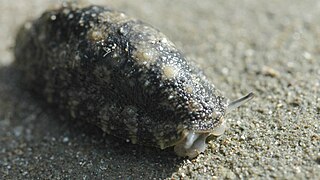Related Research Articles

Acanthocephala is a phylum of parasitic worms known as acanthocephalans, thorny-headed worms, or spiny-headed worms, characterized by the presence of an eversible proboscis, armed with spines, which it uses to pierce and hold the gut wall of its host. Acanthocephalans have complex life cycles, involving at least two hosts, which may include invertebrates, fish, amphibians, birds, and mammals. About 1420 species have been described.

Trematoda is a class within the phylum Platyhelminthes. It includes two groups of parasitic flatworms, known as flukes.

Digenea is a class of trematodes in the Platyhelminthes phylum, consisting of parasitic flatworms with a syncytial tegument and, usually, two suckers, one ventral and one oral. Adults commonly live within the digestive tract, but occur throughout the organ systems of all classes of vertebrates. Once thought to be related to the Monogenea, it is now recognised that they are closest to the Aspidogastrea and that the Monogenea are more closely allied with the Cestoda. Around 6,000 species have been described to date.
Microphallus is a genus of parasitic trematodes (flukes) in the family Microphallidae. The Greek name means "tiny penis".

Microsporidia are a group of spore-forming unicellular parasites. They were once considered protozoans or protists, but are now known to be fungi, or a sister group to fungi. Loosely 1500 of the probably more than one million species are named now. Microsporidia are restricted to animal hosts, and all major groups of animals host microsporidia. Most infect insects, but they are also responsible for common diseases of crustaceans and fish. The named species of microsporidia usually infect one host species or a group of closely related taxa. Several species, most of which are opportunistic, also infect humans.
The Aspidogastrea is a small group of flukes comprising about 80 species. It is a subclass of the trematoda, and sister group to the Digenea. Species range in length from approximately one millimeter to several centimeters. They are parasites of freshwater and marine molluscs and vertebrates. Maturation may occur in the mollusc or vertebrate host. None of the species has any economic importance, but the group is of very great interest to biologists because it has several characters which appear to be archaic.

Paragonimus is a genus of flukes (trematodes). Some tens of species have been described, but they are difficult to distinguish, so it is not clear how many of the named species may be synonyms. The name Paragonimus is derived from the combination of two Greek words, “para” and “gonimos”. Several of the species are known as lung flukes. In humans some of the species occur as zoonoses; the term for the condition is paragonimiasis. The first intermediate hosts of Paragonimus include at least 54 species of freshwater snails from superfamilies Cerithioidea and Rissooidea.
The Ascetosporea are a group of eukaryotes that are parasites of animals, especially marine invertebrates. The two groups, the haplosporids and paramyxids, are not particularly similar morphologically, but consistently group together on molecular trees, which place them near the base of the Cercozoa. Both produce spores without the complex structures found in similar groups.

Onchidiidae are a family of small, air-breathing sea slugs. They are shell-less marine pulmonate gastropod molluscs. Onchidiidae is the only family within the superfamily Onchidioidea.

Adeleorina is a suborder of parasites in the phylum Apicomplexa.
Hematodinium is a genus of dinoflagellates. Species in this genus, such as Hematodinium perezi, the type species, are internal parasites of the hemolymph of crustaceans such as the Atlantic blue crab and Norway lobster. Species in the genus are economically damaging to commercial crab fisheries, including causing bitter crab disease in the large Tanner or snow crab fisheries of the Bering Sea.
Dactylosoma is a genus of parasitic alveolates of the phylum Apicomplexia.

Lernaeocera branchialis, sometimes called cod worm, is a parasite of marine fish, found mainly in the North Atlantic. It is a marine copepod which starts life as a small pelagic crustacean larva. It is among the largest of copepods, ranging in size from 2–3 millimetres when it matures as a copepodid larva to more than 40 millimetres (1.6 in) as a sessile adult.
Aggregata is a genus of parasitic alveolates belonging to the phylum Apicomplexa.
Hyaloklossia is a genus of parasitic alveolates in the phylum Apicomplexa. Only one species in this genus is currently recognised - Hyaloklossia lieberkuehni.
Crystallospora is a genus of Apicomplexa in the family Aggregatidae.
Pseudoklossia is a genus in the phylum Apicomplexa. Species in this genus infect marine molluscs, although one species infects in an ascidian worm. The life cycle is heteroxenous.
The Eugregarinorida are the most large and diverse order of gregarines — parasitic protists belonging to the phylum Apicomplexa. Eugregarines are found in marine, freshwater and terrestrial habitats. These species possess large trophozoites that are significantly different in morphology and behavior from the sporozoites. This taxon contains most of the known gregarine species.
Cephaloidophoridae is a family of parasitic alveolates of the phylum Apicomplexia
Nematopsis (Nee-mah-top-cis) is a genus gregarine Apicomplexan of the family Porosporidae. It is an aquatic parasite of crustaceans with a molluscan intermediate host. Nematopsis has been distinguished from the similar genus Porospora by its resistant and encapsulated oocyst. Little molecular biology has been performed on the members of the Nemaptosis and species are described based on molluscan and crustacean hosts as well as oocyst structure. A total of 38 species have been described and are found all over the world.
References
- ↑ Labbé A (1899) Sporozoa. In Das Tierreich: Eine Zusammenstellung und Kennzeichnung der rezenten Tierformen, Schulze, F. E. & Bütschli, O. (eds.). R. Friedländer und Sohn, Berlin: Germany
| This Apicomplexa-related article is a stub. You can help Wikipedia by expanding it. |